Ate at any confectionary lately? Do you need a bowl of cornflakes to jumpstart your day?
If your answer to the above questions is a ‘yes’; then you are using products containing palm oil, one of the most versatile and widely used vegetable oils. According to an estimate by the Union of Concerned Scientists, the average consumer uses at least twelve products per day that contain or might contain palm oil. To add to this, the usage of palm oil has doubled over the last few years; mainly driven by demand for a healthier alternative to Trans Fats.
As per Krungsri Research, India, China, and the EU were the major consumers and importers of palm oil in 2016. Their combined imports account for 50% of the global imports.
Don’t see a problem yet? Wait.
The story underlying the palm oil we consume in our daily routine is a complex one. Though the industry offers an escape route out of poverty for people in countries like Indonesia and Malaysia, there has been an exponential rise in unregulated palm plantations in these countries. As a result, there are many plantations that have been established without any exchange of dialogue with the local community. In many cases, the plantation owners don’t compensate the local communities fairly. These communities have been dwelling on the plantation land. Although they may not necessarily own the land, the communities have been managing it across several generations.
Furthermore, the uncontrolled growth of palm plantations has led to the destruction of rainforests, due to cutting and burning of tropical forests. This has lead to skyrocketing greenhouse gas emissions and loss of habitat for endangered animals. Also, issues like poor working conditions, child labor, forced labor, trafficking of migrant workers etc. are common in this industry.
Weighing the production and demand
According to the graphical representation shown below, the global production of palm oil had doubled during 2005-2014; mainly fuelled by an increase in population, resulting in growth of the overall consumption. Palm oil production growth has been highest in Indonesia and Malaysia, and the spike is expected to continue, owing to the commodity’s affordability & versatility, despite the adversities caused in the form of rainforest destruction and CO2 emissions.
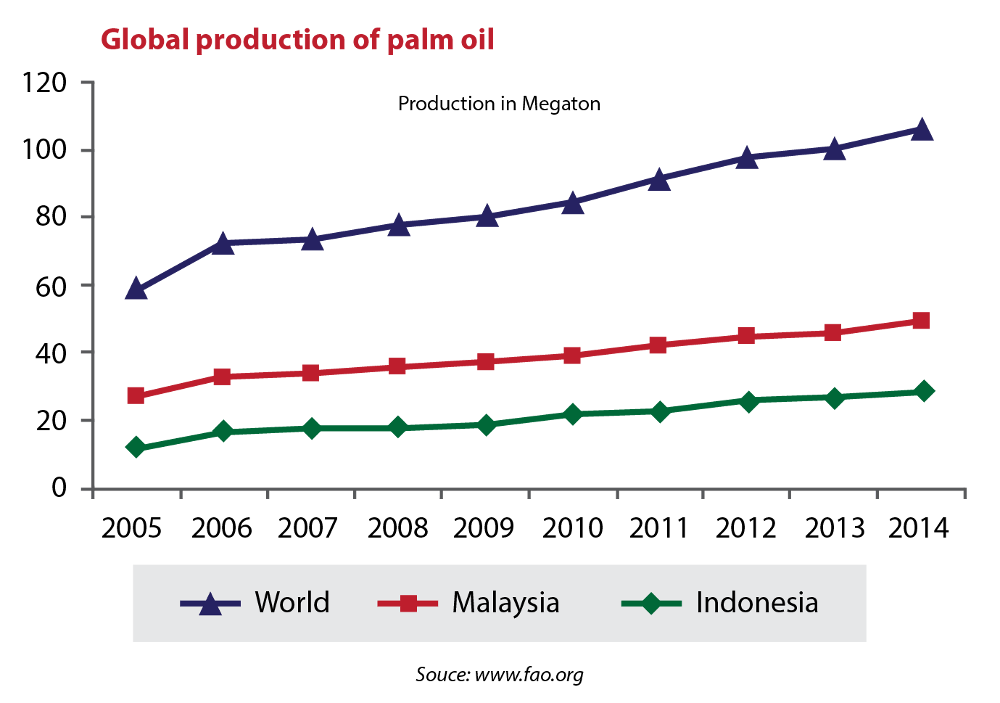
Who consumes palm oil?
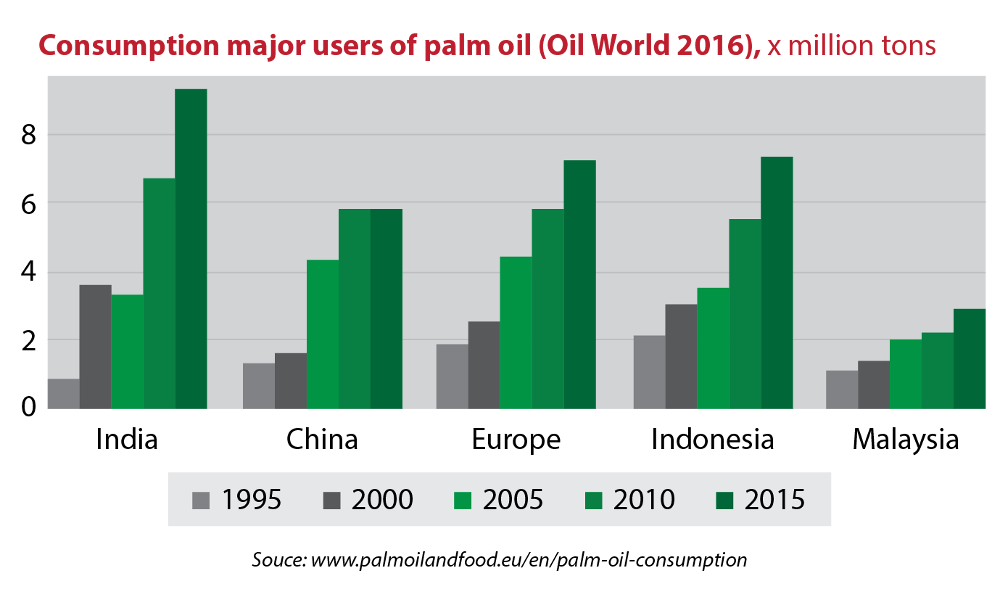
Palm oil is the most consumed oil in the world. As per the European Palm Oil Alliance, global consumption of palm oil rose to 61.1 million tons in 2015. The EU, China, India, Malaysia, and Indonesia are the largest consumers.
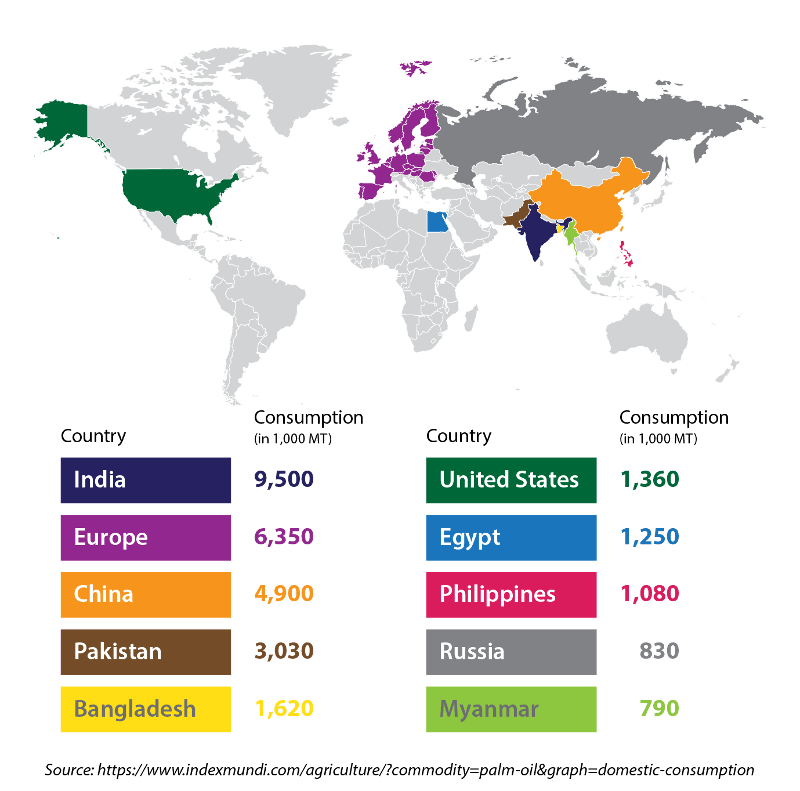
Can palm oil, as a product, attain sustainability?
While some experts believe that palm oil can never earn a place in the list of sustainable products; others believe it is possible subject to appropriate regulations. The required regulations in this space include, but are not limited to, aspects related to proper working conditions, responsibly managed land, steps towards controlling GHG emissions etc. This should result in the production of this global commodity being managed sustainably and work in tandem with the conservation of our environment and the protection of communities.
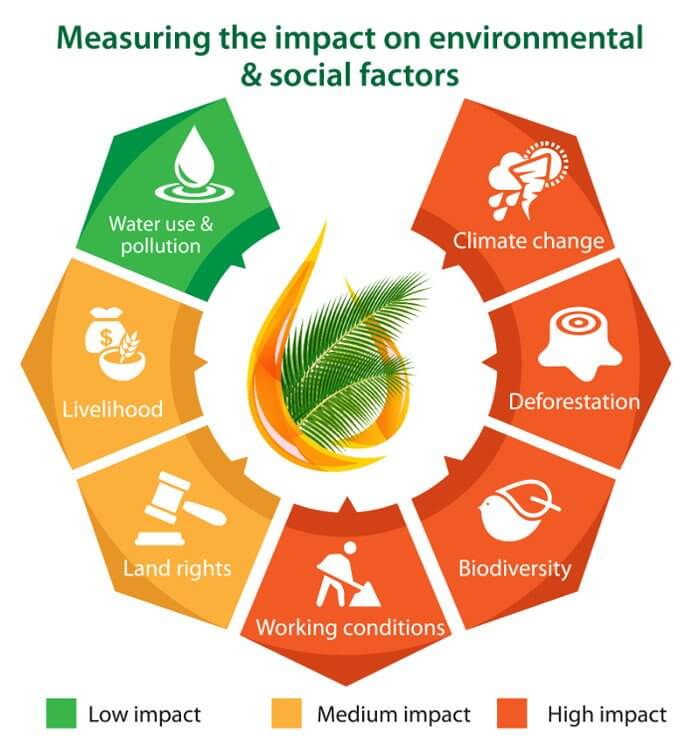
Certified sustainable palm oil refers to palm oil production that meets certain production standards. These standards are in relation to deforestation, lawfulness, transparency, and social impact laid out by the Roundtable on Sustainable Palm Oil (RSPO). According to RSPO, only 19% of the global palm oil is RSPO certified.
Investments made in palm oil companies aren’t sustainable and involve serious ESG risks. Most evident are issues like rainforest destruction and poor working conditions.
According to the 2016 edition of WWF’s Palm Oil Buyers Scorecard, various consumer brands such as Unilever, Reckitt Benckiser, and Colgate-Palmolive have fulfilled their commitments to shun palm oil production companies that have been blatantly destroying rainforests, and also neglecting human rights. Financial corporations such as BNP Paribas and HSBC have also taken a cue from this, and have been asking the producers they finance to meet sustainability standards.
To stop this situation from blowing out of proportion; organizations like World Wildlife Fund and Oxfam International are continuously working to change the palm oil supply chain. These organizations promote improved sustainability practices and production of certified sustainable palm oil. With the assistance of NGOs, policymakers can identify gaps and weaknesses in existing systems, establish priorities for assessment and strengthen of social and environmental policy safeguards.
Industry bodies addressing sustainability throughout the palm oil supply chain.
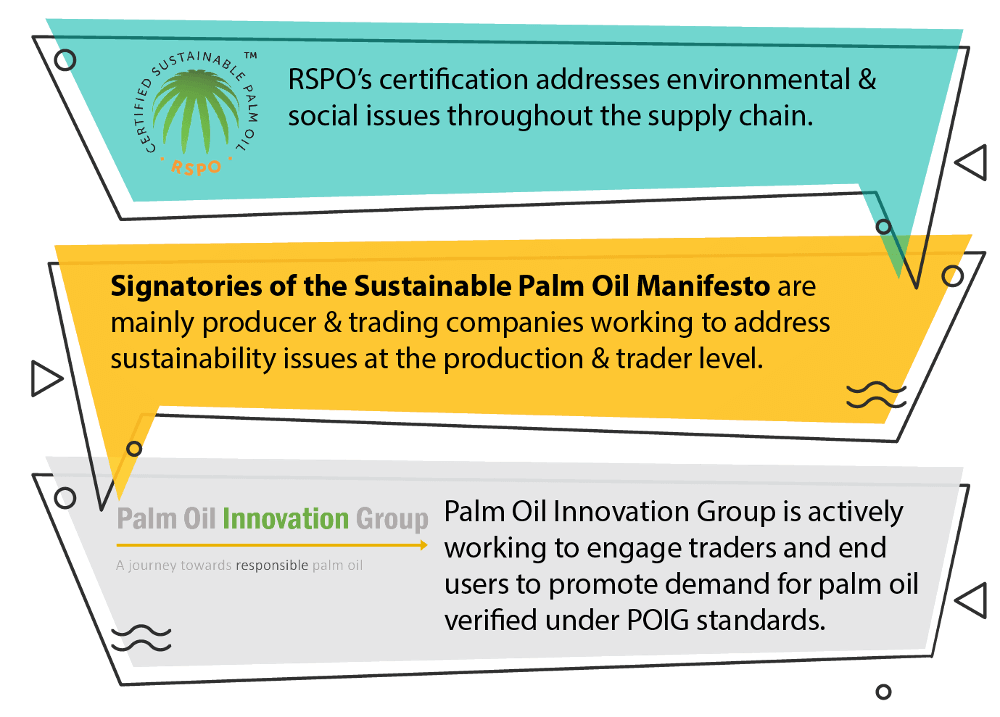
Although there are organizations which are working towards improving the overall scenario of the palm oil industry, the onus is on us, the “responsible citizens”, to contribute to the betterment of the sector.
The responsible investment community can collectively encourage companies to take the following actions to mitigate risks.
- Multi-stakeholder sustainability efforts.
Collaboration between the buyers, producers, governments, NGOs, and communities can ensure the long-term sustainability of palm oil. Investors can encourage investee companies to join these multi-stakeholder efforts and help in establishing constructive participation and progress in meeting commitments like development and support of sustainability standards.
There are numerous multi-stakeholder efforts to address the issues in regard to palm oil production. This includes collaborations between companies and local governments as well as national efforts, such as the Sustainable Palm Oil Initiative (SPO).
- Direct engagement with producers.
Wherever companies have greater visibility into their respective supply chains, they can work in tandem with the suppliers to promote better management practices.
Some of the steps that institutions involved in the palm oil sector must undertake are:
Evaluate suppliers’ public disclosures using their own websites or aggregate scoring systems such as the Zoological Society of London’s Sustainable Palm Oil Transparency Toolkit (SPOTT) platform.
- Engage suppliers on issues that need improvement. Consider dropping suppliers with egregious practices that fail to improve after several years of engagement.
- Encourage producers to grow palm oil on degraded land instead of forested land.
- Promote improvements in existing palm oil plantations to increase crop yield, instead of acquiring more land to expand production.
- Supporting government policies
In producer countries, speaking out collectively to promote transparency and legislative reform is particularly critical. Companies and investors can support efforts by governments to eliminate illegal and uncertified conversion of forests. Another focus area can be addressing the current lack of transparency regarding land tenure and asking suppliers to publish concession maps covering their entire operations, which also is a requirement for membership in the Roundtable for Sustainable Palm Oil (RSPO)
- Invest Wisely
An investor can always dig deep to find out about an investment’s exposure to the palm oil value chain.
Data from ESG research houses are always a good to have knowledge and can help in making responsible investments.
Armed with this knowledge, we can ensure our money is being invested in our values and a healthy future, helping forest conservation and protection of communities









